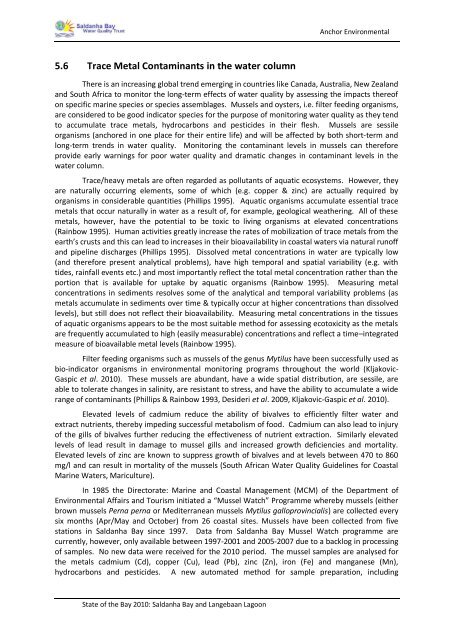State of the Bay Report 2010-Final - Anchor Environmental
State of the Bay Report 2010-Final - Anchor Environmental
State of the Bay Report 2010-Final - Anchor Environmental
Create successful ePaper yourself
Turn your PDF publications into a flip-book with our unique Google optimized e-Paper software.
5.6 Trace Metal Contaminants in <strong>the</strong> water column<br />
<strong>State</strong> <strong>of</strong> <strong>the</strong> <strong>Bay</strong> <strong>2010</strong>: Saldanha <strong>Bay</strong> and Langebaan Lagoon<br />
<strong>Anchor</strong> <strong>Environmental</strong><br />
There is an increasing global trend emerging in countries like Canada, Australia, New Zealand<br />
and South Africa to monitor <strong>the</strong> long‐term effects <strong>of</strong> water quality by assessing <strong>the</strong> impacts <strong>the</strong>re<strong>of</strong><br />
on specific marine species or species assemblages. Mussels and oysters, i.e. filter feeding organisms,<br />
are considered to be good indicator species for <strong>the</strong> purpose <strong>of</strong> monitoring water quality as <strong>the</strong>y tend<br />
to accumulate trace metals, hydrocarbons and pesticides in <strong>the</strong>ir flesh. Mussels are sessile<br />
organisms (anchored in one place for <strong>the</strong>ir entire life) and will be affected by both short‐term and<br />
long‐term trends in water quality. Monitoring <strong>the</strong> contaminant levels in mussels can <strong>the</strong>refore<br />
provide early warnings for poor water quality and dramatic changes in contaminant levels in <strong>the</strong><br />
water column.<br />
Trace/heavy metals are <strong>of</strong>ten regarded as pollutants <strong>of</strong> aquatic ecosystems. However, <strong>the</strong>y<br />
are naturally occurring elements, some <strong>of</strong> which (e.g. copper & zinc) are actually required by<br />
organisms in considerable quantities (Phillips 1995). Aquatic organisms accumulate essential trace<br />
metals that occur naturally in water as a result <strong>of</strong>, for example, geological wea<strong>the</strong>ring. All <strong>of</strong> <strong>the</strong>se<br />
metals, however, have <strong>the</strong> potential to be toxic to living organisms at elevated concentrations<br />
(Rainbow 1995). Human activities greatly increase <strong>the</strong> rates <strong>of</strong> mobilization <strong>of</strong> trace metals from <strong>the</strong><br />
earth’s crusts and this can lead to increases in <strong>the</strong>ir bioavailability in coastal waters via natural run<strong>of</strong>f<br />
and pipeline discharges (Phillips 1995). Dissolved metal concentrations in water are typically low<br />
(and <strong>the</strong>refore present analytical problems), have high temporal and spatial variability (e.g. with<br />
tides, rainfall events etc.) and most importantly reflect <strong>the</strong> total metal concentration ra<strong>the</strong>r than <strong>the</strong><br />
portion that is available for uptake by aquatic organisms (Rainbow 1995). Measuring metal<br />
concentrations in sediments resolves some <strong>of</strong> <strong>the</strong> analytical and temporal variability problems (as<br />
metals accumulate in sediments over time & typically occur at higher concentrations than dissolved<br />
levels), but still does not reflect <strong>the</strong>ir bioavailability. Measuring metal concentrations in <strong>the</strong> tissues<br />
<strong>of</strong> aquatic organisms appears to be <strong>the</strong> most suitable method for assessing ecotoxicity as <strong>the</strong> metals<br />
are frequently accumulated to high (easily measurable) concentrations and reflect a time–integrated<br />
measure <strong>of</strong> bioavailable metal levels (Rainbow 1995).<br />
Filter feeding organisms such as mussels <strong>of</strong> <strong>the</strong> genus Mytilus have been successfully used as<br />
bio-indicator organisms in environmental monitoring programs throughout <strong>the</strong> world (Kljakovic-<br />
Gaspic et al. <strong>2010</strong>). These mussels are abundant, have a wide spatial distribution, are sessile, are<br />
able to tolerate changes in salinity, are resistant to stress, and have <strong>the</strong> ability to accumulate a wide<br />
range <strong>of</strong> contaminants (Phillips & Rainbow 1993, Desideri et al. 2009, Kljakovic-Gaspic et al. <strong>2010</strong>).<br />
Elevated levels <strong>of</strong> cadmium reduce <strong>the</strong> ability <strong>of</strong> bivalves to efficiently filter water and<br />
extract nutrients, <strong>the</strong>reby impeding successful metabolism <strong>of</strong> food. Cadmium can also lead to injury<br />
<strong>of</strong> <strong>the</strong> gills <strong>of</strong> bivalves fur<strong>the</strong>r reducing <strong>the</strong> effectiveness <strong>of</strong> nutrient extraction. Similarly elevated<br />
levels <strong>of</strong> lead result in damage to mussel gills and increased growth deficiencies and mortality.<br />
Elevated levels <strong>of</strong> zinc are known to suppress growth <strong>of</strong> bivalves and at levels between 470 to 860<br />
mg/l and can result in mortality <strong>of</strong> <strong>the</strong> mussels (South African Water Quality Guidelines for Coastal<br />
Marine Waters, Mariculture).<br />
In 1985 <strong>the</strong> Directorate: Marine and Coastal Management (MCM) <strong>of</strong> <strong>the</strong> Department <strong>of</strong><br />
<strong>Environmental</strong> Affairs and Tourism initiated a “Mussel Watch” Programme whereby mussels (ei<strong>the</strong>r<br />
brown mussels Perna perna or Mediterranean mussels Mytilus galloprovincialis) are collected every<br />
six months (Apr/May and October) from 26 coastal sites. Mussels have been collected from five<br />
stations in Saldanha <strong>Bay</strong> since 1997. Data from Saldanha <strong>Bay</strong> Mussel Watch programme are<br />
currently, however, only available between 1997-2001 and 2005-2007 due to a backlog in processing<br />
<strong>of</strong> samples. No new data were received for <strong>the</strong> <strong>2010</strong> period. The mussel samples are analysed for<br />
<strong>the</strong> metals cadmium (Cd), copper (Cu), lead (Pb), zinc (Zn), iron (Fe) and manganese (Mn),<br />
hydrocarbons and pesticides. A new automated method for sample preparation, including

















